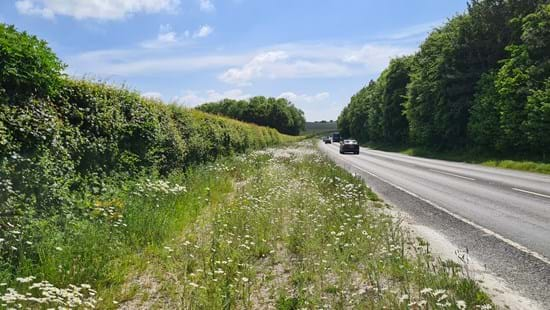National Highways has taken the opportunity to sow wildflowers alongside the A35 in Dorset while carrying out two recent drainage improvement schemes, improving biodiversity and reducing costs.
As part of its biodiversity commitment, the government-owned company liaised and worked with the bordering Duchy of Cornwall estate as how best to landscape the locations, near Dorchester.
Instead of importing topsoil and seeding to return the verges to grass, it funded a scheme to introduce native wildflowers to the roadsides, which it said are not only visually appealing but will enhance and promote habitats for bees, butterflies and other insects.
With funding from National Highways’ environment and wellbeing designated fund, a scheme was carried out last autumn to seed and restore 2,000 square metres of verge around the Monkey’s Jump roundabout, 3,000 square metres around the Max Gate junction and a further 1,000 square metres of land around the Max Gate pond area.
Utilising chalk waste and rough soils from the drainage schemes, the initiative also reduced the export and import of materials.
The wildflower seeding alongside the A35 included the Horseshoe and Kidney Vetch species, Bee Orchids, Cowslip and Oxeye Daisy.

National Highways’ Environmental Advisor Ben Hewlett said: ‘We now have a policy to introduce low nutrient soils and wildflower verges as part of our major projects programme and working with groups such as Natural England and Butterfly Conservation, it’s good to see this spreading into our regional maintenance and improvement work.’
As part of the project, contractors Knighton Countryside created winter havens for other species, such as toads, hedgehogs and snakes, out of the cuttings, and by avoiding the import of topsoil to the site, the project saved £75,000 in material and labour costs, as well as a significant saving in carbon emissions associated with haulage.
Clare Warburton, Natural England's green infrastructure principal advisor, said: ‘We welcome this step change in the way road verges are designed and managed, and this could make a significant contribution to recovering nature on our verges.
‘Low nutrient verges can help to reduce the likelihood of invasive species like creeping thistle, and increase native species we love to see, like oxeye daisy and bird’s-foot trefoil and even rarer flowers, such as orchids, as well as being great for bees and pollinators.’
Using its Designated Funding programme, National Highways is also delivering schemes to enhance biodiversity alongside the verges of the M4 in Wiltshire and the A46 near Bath.





